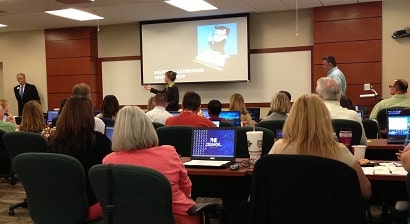Facilitation Skills for Classroom and Virtual Instructors
As a learning professional, it’s an exciting time to be in the training and development world. We have so many new training options at our disposal – social, informal, mobile, gamification, etc. This doesn’t mean the more traditional methods have gone away. Classroom is still a very effective training choice.
But I’m beginning to realize that learning professionals might need to develop their areas of specialization. For example, I might know a lot about mobile training but not enough to build a mobile training app. Reversely, a person could be an awesome classroom facilitator but that doesn’t mean they will be an equally awesome virtual classroom instructor.
Let me wander off the beaten path for just a second and point out that virtual classroom facilitation isn’t the same as a webinar. The goals for each are different. Virtual classroom instruction is like classroom training…but virtual. And even though I’m describing the experience for the participant like it’s “classroom training on your computer” that doesn’t mean that the facilitation piece is the same as classroom training.
During this year’s ASTD TechKnowledge Conference, I had the chance to hear Annamarie Lang, senior consultant with Development Dimensions International (DDI) share her company’s experience with virtual classrooms and the skills necessary to be an excellent virtual instructor.
Annamarie’s presentation got me thinking about the skills we must have to be a classroom instructor and how that changes when we are in the virtual classroom. Obviously, content knowledge and participant engagement is essential in both situations. But there are a few additional areas where we have to shift our focus for virtual instruction:
Technology – Not only do we have to know the technology we’re using, but we need the ability to talk and use the tools at the same time. With virtual facilitation, points on the screen may need to be highlighted or white boarded while the discussion continues.
Non-verbal communication skills – In the virtual classroom, participants can’t see our body language. Speaking clearly and with confidence is key. In addition, we have to be able to change tone, inflection, pace, etc. to communicate effectively.
Participant interaction – Important in both types of training but, with virtual classrooms, we have to remember to allow for silence. In the classroom environment, we can see when participants are processing information. We have to allow for the same in a virtual setting.
Questions and discussion – Virtual facilitators have to become comfortable calling on participants by name to contribute. In the classroom environment, a facilitator can pose a question to the group and get responses. Participants can raise their hands and take turns. This is very hard to do virtually.
As technology and training become even more commonplace, those of us in the training world will have to develop our skills to be effective in these different environments. We cannot simply take one set of skills and expect them to transfer completely. Adjustments must be made for participants to have a good learning experience and, more importantly, for the training objectives to be met.
Image courtesy of HR Bartender
0